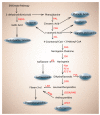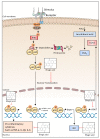Opinion on the Hurdles and Potential Health Benefits in Value-Added Use of Plant Food Processing By-Products as Sources of Phenolic Compounds
- PMID: 30404239
- PMCID: PMC6275048
- DOI: 10.3390/ijms19113498
Opinion on the Hurdles and Potential Health Benefits in Value-Added Use of Plant Food Processing By-Products as Sources of Phenolic Compounds
Abstract
Plant foods, their products and processing by-products are well recognized as important sources of phenolic compounds. Recent studies in this field have demonstrated that food processing by-products are often richer sources of bioactive compounds as compared with their original feedstock. However, their final application as a source of nutraceuticals and bioactives requires addressing certain hurdles and challenges. This review discusses recent knowledge advances in the use of plant food processing by-products as sources of phenolic compounds with special attention to the role of genetics on the distribution and biosynthesis of plant phenolics, as well as their profiling and screening, potential health benefits, and safety issues. The potentialities in health improvement from food phenolics in animal models and in humans is well substantiated, however, considering the emerging market of plant food by-products as potential sources of phenolic bioactives, more research in humans is deemed necessary.
Keywords: cancer; cardiovascular disease; diabetes; inflammation; microbiological safety; obesity; phenolic antioxidants; phenolic bioavailability; phenolic biosynthesis; phenolic identification.
Conflict of interest statement
The authors declare no conflict of interest.
Figures






Similar articles
-
Recent trends in extraction of plant bioactives using green technologies: A review.Food Chem. 2021 Aug 15;353:129431. doi: 10.1016/j.foodchem.2021.129431. Epub 2021 Mar 3. Food Chem. 2021. PMID: 33714109 Review.
-
Phenolic Bioactives From Plant-Based Foods for Glycemic Control.Front Endocrinol (Lausanne). 2022 Jan 18;12:727503. doi: 10.3389/fendo.2021.727503. eCollection 2021. Front Endocrinol (Lausanne). 2022. PMID: 35116002 Free PMC article. Review.
-
Food processing strategies to enhance phenolic compounds bioaccessibility and bioavailability in plant-based foods.Crit Rev Food Sci Nutr. 2018;58(15):2531-2548. doi: 10.1080/10408398.2017.1331200. Epub 2017 Aug 24. Crit Rev Food Sci Nutr. 2018. PMID: 28609142 Review.
-
Neuroprotective Effects of Agri-Food By-Products Rich in Phenolic Compounds.Nutrients. 2023 Jan 14;15(2):449. doi: 10.3390/nu15020449. Nutrients. 2023. PMID: 36678322 Free PMC article. Review.
-
Evolution and current status of research in phenolic compounds.Phytochemistry. 2007 Nov-Dec;68(22-24):2722-35. doi: 10.1016/j.phytochem.2007.06.012. Epub 2007 Jul 23. Phytochemistry. 2007. PMID: 17643453 Review.
Cited by
-
Grape UV-C irradiation in the postharvest period as a tool to improve sensorial quality and anthocyanin profile in 'Cabernet Sauvignon' wine.J Food Sci Technol. 2022 May;59(5):1801-1811. doi: 10.1007/s13197-021-05191-5. Epub 2021 Jul 12. J Food Sci Technol. 2022. PMID: 35531414 Free PMC article.
-
In Vitro Digestion of Peanut Skin Releases Bioactive Compounds and Increases Cancer Cell Toxicity.Antioxidants (Basel). 2023 Jun 28;12(7):1356. doi: 10.3390/antiox12071356. Antioxidants (Basel). 2023. PMID: 37507896 Free PMC article.
-
Insoluble-Bound Polyphenols Released from Guarana Powder: Inhibition of Alpha-Glucosidase and Proanthocyanidin Profile.Molecules. 2020 Feb 5;25(3):679. doi: 10.3390/molecules25030679. Molecules. 2020. PMID: 32033416 Free PMC article.
-
Wheat and Rice beyond Phenolic Acids: Genetics, Identification Database, Antioxidant Properties, and Potential Health Effects.Plants (Basel). 2022 Nov 29;11(23):3283. doi: 10.3390/plants11233283. Plants (Basel). 2022. PMID: 36501323 Free PMC article. Review.
-
Ex Vivo Study on the Antioxidant Activity of a Winemaking By-Product Polyphenolic Extract (Taurisolo®) on Human Neutrophils.Antioxidants (Basel). 2021 Jun 23;10(7):1009. doi: 10.3390/antiox10071009. Antioxidants (Basel). 2021. PMID: 34201732 Free PMC article.
References
-
- Shahidi F., Ambigaipalan P. Phenolics and polyphenolics in foods, beverages and spices: Antioxidant activity and health effects—A review. J. Funct. Foods. 2015;18:820–897. doi: 10.1016/j.jff.2015.06.018. - DOI
-
- Zhang H., Tsao R. Dietary polyphenols, oxidative stress and antioxidant and anti-inflammatory effects. Curr. Opin. Food Sci. 2016;8:33–42. doi: 10.1016/j.cofs.2016.02.002. - DOI
-
- Pradeep P.M., Sreerama Y.N. Soluble and bound phenolics of two different millet genera and their milled fractions: Comparative evaluation of antioxidant properties and inhibitory effects on starch hydrolysing enzyme activities. J. Funct. Foods. 2017;35:682–693. doi: 10.1016/j.jff.2017.06.033. - DOI
Publication types
MeSH terms
Substances
Grants and funding
- 2015/00336-4/Fundação de Amparo à Pesquisa do Estado de São Paulo
- 2012/17683-0/Fundação de Amparo à Pesquisa do Estado de São Paulo
- xxx/Coordenação de Aperfeiçoamento de Pessoal de Nível Superior
- 3180432/Fondo Nacional de Desarrollo Científico y Tecnológico
- 2016/15563-9/Fundação de Amparo à Pesquisa do Estado de São Paulo
- PYT-2017-0490/Fundación para la Innovación Agraria - FIA
- 403328/2016-0/Conselho Nacional de Desenvolvimento Científico e Tecnológico
- 301108/2016-1/Conselho Nacional de Desenvolvimento Científico e Tecnológico
- 2015/50333-1/Fundação de Amparo à Pesquisa do Estado de São Paulo
- xxx/Natural Sciences and Engineering Research Council of Canada
LinkOut - more resources
Full Text Sources

